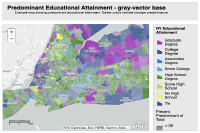 Hide Table of Contents
Hide Table of Contents
 Analysis
Analysis
 Dynamic Layers
Dynamic Layers
 Editing
Editing
 Feature Layers
Feature Layers
 Feature Table
Feature Table
 Graphics
Graphics
 Map
Map
 Mobile
Mobile
 Online and Portal
Online and Portal
 Popups and Info Windows
Popups and Info Windows
 Query and Select
Query and Select
 Renderers, Symbols, Visualization
Renderers, Symbols, Visualization
 Search
Search

Web map by ID
Explore in the sandbox
Open in CodePen
View live sample
Description
This sample displays a map generated using the ArcGIS.com map viewer. The map's author used the tools in the map viewer to select a basemap, add operational layers, define an initial extent and create popup windows.
The ArcGIS API for JavaScript has a utility method that allow you to use maps from ArcGIS.com or your own Portal in a JavaScript application: esri/arcgis/utils.createMap, which is used in this sample. In addition, you can also specify a portal URL, via thearcgisUrlproperty,besides the default ArcGIS Online URL ofhttp://www.arcgis.com/sharing/rest/content/items.
Code
<!DOCTYPE html>
<html>
<head>
<meta http-equiv="Content-Type" content="text/html; charset=utf-8">
<meta name="viewport" content="initial-scale=1, maximum-scale=1,user-scalable=no">
<title>Create web map from id</title>
<link rel="stylesheet" href="https://js.arcgis.com/3.46/dijit/themes/claro/claro.css">
<link rel="stylesheet" href="https://js.arcgis.com/3.46/esri/css/esri.css">
<script src="https://js.arcgis.com/3.46/" data-dojo-config="async:true"></script>
<script>
require([
"dojo/parser",
"dojo/ready",
"dijit/layout/BorderContainer",
"dijit/layout/ContentPane",
"dojo/dom",
"esri/map",
"esri/urlUtils",
"esri/arcgis/utils",
"esri/dijit/Legend",
"esri/dijit/Scalebar",
"dojo/domReady!"
], function (
parser,
ready,
BorderContainer,
ContentPane,
dom,
Map,
urlUtils,
arcgisUtils,
Legend,
Scalebar
) {
ready(function () {
parser.parse();
//if accessing webmap from a portal outside of ArcGIS Online, uncomment and replace path with portal URL
//arcgisUtils.arcgisUrl = "https://pathto/portal/sharing/content/items";
arcgisUtils.createMap("ae2fdf0e6aeb4d5dbc2dd97f88bf5531", "map").then(function (response) {
//update the app
dom.byId("title").innerHTML = response.itemInfo.item.title;
dom.byId("subtitle").innerHTML = response.itemInfo.item.snippet;
var map = response.map;
//add the scalebar
var scalebar = new Scalebar({
map: map,
scalebarUnit: "english"
});
//add the legend. Note that we use the utility method getLegendLayers to get
//the layers to display in the legend from the createMap response.
var legendLayers = arcgisUtils.getLegendLayers(response);
var legendDijit = new Legend({
map: map,
layerInfos: legendLayers
}, "legend");
legendDijit.startup();
});
});
});
</script>
<style>
html,
body {
height: 100%;
width: 100%;
margin: 0;
padding: 0;
}
body {
font-family: "Helvetica";
}
#header {
background-color: #E8E8E8;
height: 65px;
margin: 5px 5px;
}
#mainWindow {
width: 100%;
height: 100%;
}
#title {
padding-top: 2px;
padding-left: 10px;
font-size: 18pt;
font-weight: 700;
}
#subtitle {
font-size: small;
padding-left: 40px;
}
#rightPane {
background-color: #E8E8E8;
margin: 5px;
width: 20%;
}
#map {
margin: 5px;
padding: 0;
}
</style>
</head>
<body class="claro">
<div id="mainWindow" data-dojo-type="dijit/layout/BorderContainer" data-dojo-props="design:'headline'">
<div id="header" data-dojo-type="dijit/layout/ContentPane" data-dojo-props="region:'top'">
<div id="title"></div>
<div id="subtitle"></div>
</div>
<div id="map" data-dojo-type="dijit/layout/ContentPane" data-dojo-props="region:'center'"></div>
<div id="rightPane" data-dojo-type="dijit/layout/ContentPane" data-dojo-props="region:'right'">
<div id="legend"></div>
</div>
</div>
</body>
</html>